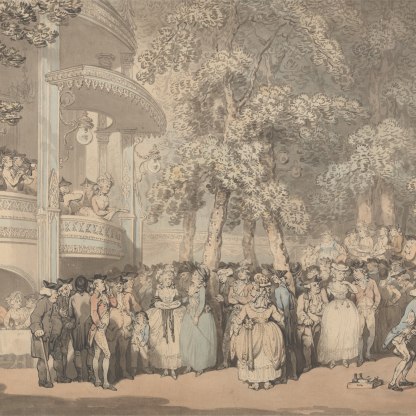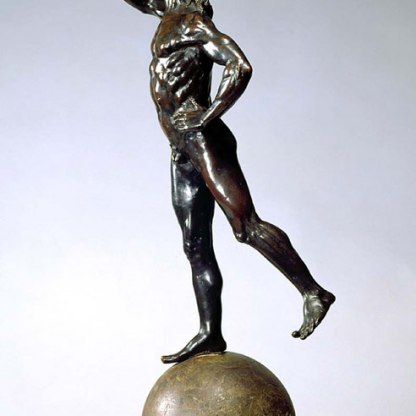Model for a Sculpture of George Frideric Handel

A Sculptor of some merrit has several years been in England, and labouring to gain reputation has lately, as mentioned in the news papers, made a Statue in Marble of Mr Handel, the famous Master of Music, and great composer of Operas &c.
George Vertue, 1738
This small terracotta was made as a model for the celebrated sculpture of George Frideric Handel mentioned above. The finished work, now in the Victoria and Albert Museum, was carved from a single block of marble and erected in the fashionable Vauxhall Pleasure Gardens on the south bank of the Thames in London in April 1738. The Gardens can be seen left, in a painting made c. 1751 by the Venetian artist Canaletto, now in a private collection.
The statue immediately received enthusiastic attention from both press and public. Poems were written in praise of it, and it launched the career of the French sculptor Louis-François Roubiliac. The publicist for Vauxhall Gardens likened Roubiliac to Pygmalion, the mythical Greek sculptor whose statue came to life. He spoke of
Fam'd Handel breathing, though transformed to stone.
But the admiration aroused by the statue was not simply due to the mastery of the artist or the celebrity of his subject, although both were substantial. The statue was an object of fascination because of its informality and realism, and because at the time living people, unless they were monarchs or military commanders, were simply not accorded the honour of a public statue.
In an age in which the periwig was still a staple of the male wardrobe, when public figures were usually depicted in their finest, most formal garb, Roubiliac's Handel was truly original. The great composer is shown wearing a night cap and loose gown. The buttons on his breeches are undone. His right foot has come out of his slipper. His elbow leans casually upon a pile of books on a plinth.
Handel's face is a mask of concentration as he bends down to listen to the notes plucked from the strings of his lyre. It is as if he has suddenly risen from bed to capture a tune that has been troubling his sleep and hasn't bothered to get dressed properly. We are witnessing the act of composition, an intense, fleeting moment of creativity. A naked baby putto, unseen by the distracted composer, transcribes the notes. A bass viol lies at his feet.
Though made as a model for the larger, costlier work, this clay statuette is a masterpiece in its own right and found itself on the art market soon after its completion. Considering that it was made as a working model, a kind of three-dimensional sketch, the detail is superb: Handel's toes can be seen through the thin fabric of the right stocking; the veins and fingernails are visible on his hand.
The Fitzwilliam is rich in Handeliana – objects associated with the composer. The founder of the Museum was an ardent admirer, and owned fifteen volumes of manuscript copies of Handel's music. Right is a page from the overture to The Water Musick, written in 1717 [Mus.MS.447.p2]. The manuscripts are now stored in a bookcase in the Museum reputed once to have belonged to Handel, left [M.1-1902].
Themes and periods
Data from our collections database
Terracotta, modelled in the round. The composer is seated on a plinth, plucking the strings of a lyre. He is shown in undress, wearing a night-cap and gown, and slippers, one of which has fallen off and is under his foot. A boy 'recording angel' sits at his feet taking down the notes.
Thomas Hudson by 1751); sold in his sale, 26th February 1785, lot 37; purchased by Nathaniel Smith and sold by him to his ma;ster, Joseph Nollekens; sold in his sale, 3rd July, 1823, lot 60 (as by Carlini); purchased by 'Hamlet, the silversmith', presumably Thomas Hamlet; probably purchased for Northwick Park at Hamlet's sale held by Robins, 29th July, 1833 (only recorded copy of the sale cat. derives from the Northwick Park Library); Captain E.G. Spencer-Churchill (1876-1964), Northwick, by whom given to the Fitzwilliam Museum.
Legal notes
Given by Captain E.G. Spencer-Churchill
Acquisition and important dates
- Method of acquisition: Given
- Dates: 1922-12-07
Dating
In depicting Handel in the act of composing, Roubiliac encourages us to imagine the the sound of the music being played. Eyes half-shut, the composer leans towards his lyre (a small stringed instrument), concentrating on the notes produced as he plucks the strings. At his feet, his amanuensis (a naked putto) listens carefully, scribbling down the score as Handel plays. The music is probably for Alexander’s Feast, composed in 1736, in which lute and oboe feature (as shown in the sculpture). On the unveiling of the marble statue in April 1738, visitors were astounded by its realism, and would no doubt have enjoyed being able to compare the sculpture with the real man, as Handel regularly frequented the Gardens.
This terracotta was the model for Roubiliac’s first major work after settling in London in c.1730: a life-size statue in Carrara marble of the famous composer, Handel made for display in the Vauxhall Pleasure Gardens (now in the Victoria and Albert Museum). Life-size marble statues were the most expensive type of portrait sculpture, traditionally reserved for monarchs and military heroes and normally commissioned for prominent public spaces. Sitters were generally shown standing and dressed in formal attire. The fact that Handel was a German musician, portrayed in casual attire in a relaxed pose, made this informal image a radical departure from accepted convention.
- 18th Century, second quarter
- George II
- Production date: before AD 1738
Maker(s)
- Roubiliac, Louis François Sculptor
Note
In depicting Handel in the act of composing, Roubiliac encourages us to imagine the the sound of the music being played. Eyes half-shut, the composer leans towards his lyre (a small stringed instrument), concentrating on the notes produced as he plucks the strings. At his feet, his amanuensis (a naked putto) listens carefully, scribbling down the score as Handel plays. The music is probably for Alexander’s Feast, composed in 1736, in which lute and oboe feature (as shown in the sculpture). On the unveiling of the marble statue in April 1738, visitors were astounded by its realism, and would no doubt have enjoyed being able to compare the sculpture with the real man, as Handel regularly frequented the Gardens.
This terracotta was the model for Roubiliac’s first major work after settling in London in c.1730: a life-size statue in Carrara marble of the famous composer, Handel made for display in the Vauxhall Pleasure Gardens (now in the Victoria and Albert Museum). Life-size marble statues were the most expensive type of portrait sculpture, traditionally reserved for monarchs and military heroes and normally commissioned for prominent public spaces. Sitters were generally shown standing and dressed in formal attire. The fact that Handel was a German musician, portrayed in casual attire in a relaxed pose, made this informal image a radical departure from accepted convention.
Place(s) associated
- London
Materials used in production
Read more about this recordStories, Contexts and Themes
Other highlight objects you might like
Suggested Curating Cambridge products
Sign up to our emails
Be the first to hear about our news, exhibitions, events and more…


![Four Seasons dancing in a landscape to the accompaniment of the god's lyre [PD.27-1952]](https://content.fitz.ms/fitz-website/assets/PD.27-1952_201202_adn21_dc1.jpg?key=exhibition)





